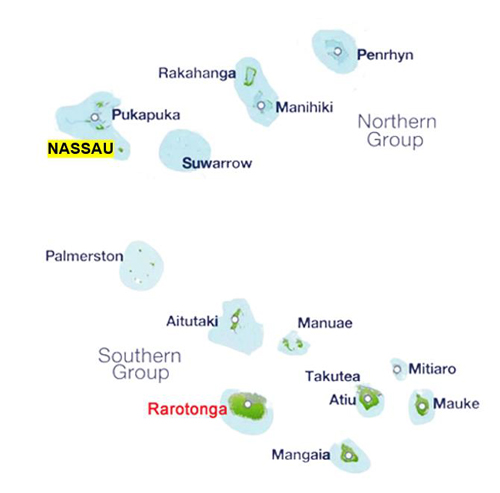
Photo: NZ Ministry of Foreign Affairs and Trade

There are no commercial air or sea services so your only chance of visiting the island is by getting first to the sister island of Pukapuka and hoping an islander there will take you on their boat. The island is surrounded by a reef flat which is 90 to 130 metres wide (98 to 142 yards) on all but the north side where it's narrower. It's a not an easy journey even though access was improved recently wth a new passage and jetty. Money has also been earmarked by the government to upgrade the harbour.
There's no tourist accommodation so if you can get there you will have to arrange to stay with a local family.
Probably the most extraordinary sight on Nassau is the remains of the Tonga registered cargo ship, Manuvai which was wrecked on the island on 28 December, 1988. Tony Probst from California kindly provided these pictures, and he tells me that the ship ran aground on the reef when the crew fell asleep in the early hours of the morning. The vessel was holed during attempts to refloat it and soon after, a cyclone lifted it up and it landed upright in the middle of the island where it remains to this day...rusting among the abundant vegetation
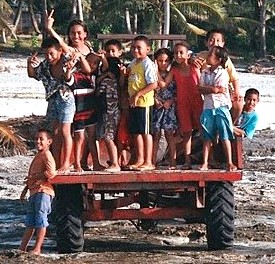
Nearly half of the population are children who are taught in the little school which opened in 1964
Asian fishing boats visit occasionally...and illegally. They don't bother going through the official ports of entry and islanders never openly acknowledge the visits. But evidence of them is everywhere. Korean fishing floats, Japanese jewellery and canned goods are the signs. And David Stanley in his South Pacific Moon Handbook says "the children of these encounters also add an exotic element to the local population".
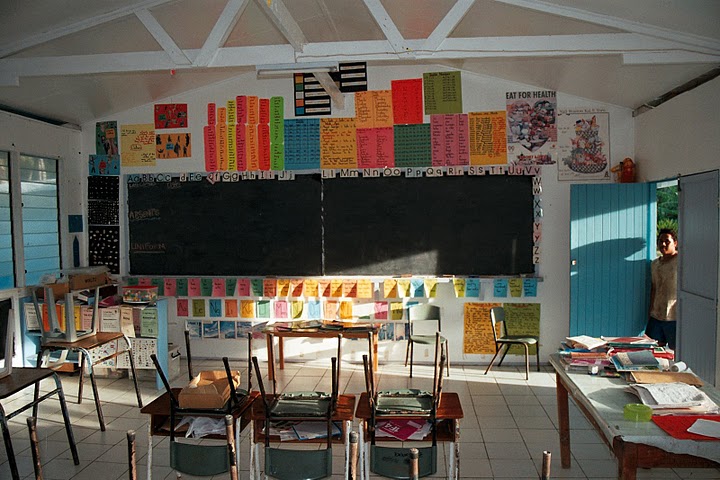
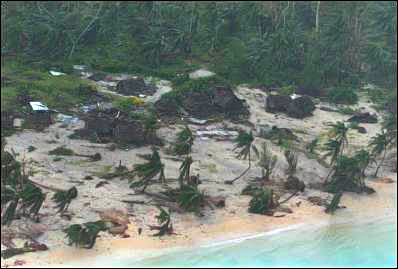
Cyclones are a fact of life in this part of the world. One of the worst was in 2005 when Cyclone Percy hit Nassau and neighbouring Pukapuka head on causing widespread damage. At one stage, there was discussion about abandoning the two islands, but the islanders are made of tough stuff and battled to rebuild
Photo: NZ Defence Force


New Zealand-born psychologist, writer and internationally famous former comedienne, Pamela Stephenson is one of very few outsiders to have visited Nassau, and hers is a rare account of what it's like. In her fascinating book "Treasure Islands"* she says that most residents have never seen a white person, other than in pictures. Her first impression was about the reticence with which she was greeted:
"I was taken aback the people generally did not move towards me, but continued sitting, one group gathered under a palm-thatched boatshed, and the other around a man on a motor scooter who turned out to the be the chief". 'The people are shy,' said Poila (who guided her ashore). 'we don't get many visitors.'"
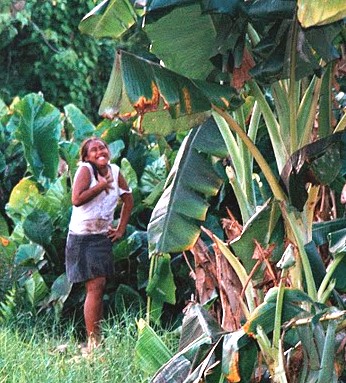
And she tells how she was "utterly thrilled" to see people carrying on life as they had for decades:
"Here a man was shaving a coconut to make coconut cream, there a woman was weaving dry palm fronds to make thatch for her house".
"Treasure Islands" is published by Headline Book Publishing, London (ISBN 0 7553 1285)

Nassau orginally belonged to the islanders of Pukapuka and was called Te Nuku-o-Ngalewu which means LAND OF NAGELU after the Pukapukan who was put in charge of it. When the two islands fell out with each other, it was renamed DESERTED ISLAND (Te Motu Ngaongao) supposedly by the islanders of Manihiki who drifted to the island and found it uninhabited.
In 1803, it got yet another name - ADELE ISLAND - after the ship of the first discoverer. About 20 years later it was renamed LYDRA ISLAND by another explorer, then RANGER ISLAND after the London whale ship "Ranger". An American whaler May Mitchell decided in 1834 that it should bear his name and called it MITCHELL ISLAND.

It wasn't until 1835 that it finally got the name it's known by today. Another American whaler, John D. Sampson named it after his vessel, the NASSAU. It's not known why that name finally stuck, especially as another whale ship which sighted the island the following year tried to rename it NEW-PORT ISLAND!
Acknowledgement: The following photos were taken by various members of the crew of the R/V Bounty Bay in May 2009 including Richard Gibbard, David Russell, Craig Morley and Leo Sovero: women in the taro fields, children on the back of a tractor
EXPLORE THE SISTER ISLAND OF